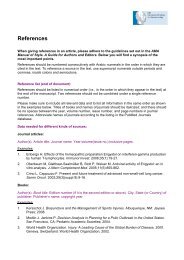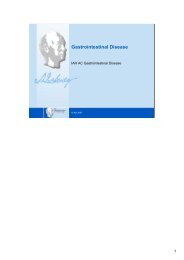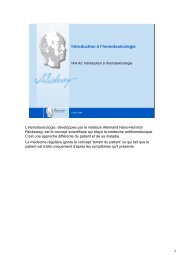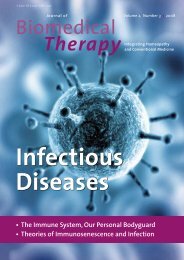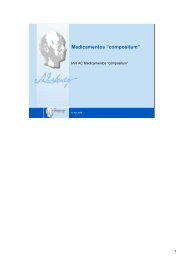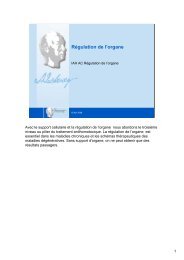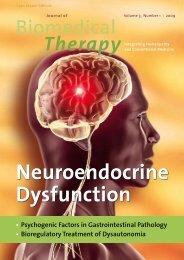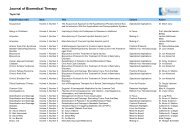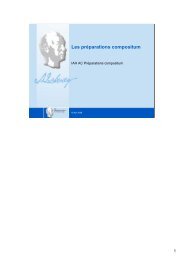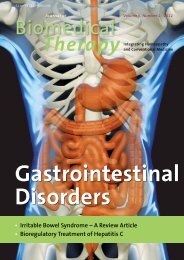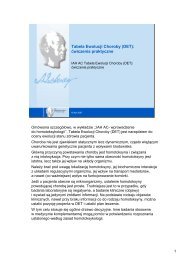The Mosaic of Evidence - International Academy of Homotoxicology
The Mosaic of Evidence - International Academy of Homotoxicology
The Mosaic of Evidence - International Academy of Homotoxicology
Create successful ePaper yourself
Turn your PDF publications into a flip-book with our unique Google optimized e-Paper software.
<strong>The</strong> <strong>Mosaic</strong> <strong>of</strong> <strong>Evidence</strong><br />
Multifaceted <strong>Evidence</strong> Based Research Results<br />
in Modern Homeopathy<br />
© IAH 2007
Objective <strong>of</strong> this Presentation<br />
Overview <strong>of</strong><br />
research strategy<br />
and practical<br />
illustration<br />
Presentation <strong>of</strong><br />
examples /<br />
highlights in<br />
© IAH 2007<br />
• Main vision and goals <strong>of</strong> research<br />
• <strong>The</strong> “evidence mosaic” concept<br />
• Basic research<br />
• Clinical research<br />
2
<strong>The</strong> Vision<br />
• In terms <strong>of</strong> an effective and well tolerable patient treatment<br />
<strong>The</strong> vision is<br />
© IAH 2007<br />
To foster the unique position occupied by<br />
Heel within medicine by building a bridge<br />
between homeopathy and conventional<br />
medicine<br />
To make Heel the world leader in modern,<br />
evidence-based natural products by<br />
supporting and developing Heel products<br />
and Reckeweg’s theory.<br />
3
Main Goal <strong>of</strong> Research <strong>International</strong><br />
• Development <strong>of</strong> a multifaceted, synergistic evidence base for<br />
important Heel products:<br />
© IAH 2007<br />
4
Further Goals <strong>of</strong> Research <strong>International</strong><br />
• Support and propagate the theory <strong>of</strong> homotoxicology using the<br />
appropriate basic and clinical research models<br />
• Improve the image <strong>of</strong> homeopathy by supporting “generic”<br />
research in collaboration with other homeopathic companies<br />
© IAH 2007<br />
5
What is an <strong>Evidence</strong> <strong>Mosaic</strong>?<br />
• A multifaceted evidence base<br />
which is more than the sum<br />
<strong>of</strong> its parts:<br />
<strong>The</strong> <strong>Evidence</strong> <strong>Mosaic</strong> is based on three pillars:<br />
Randomized Controlled Trials<br />
Observational Studies<br />
Basic Research<br />
Randomized Controlled Trials<br />
© IAH 2007<br />
Randomized Controlled Trials (RCTs) are required to demonstrate the efficacy <strong>of</strong> a treatment. RCTs usually take place in highly selective<br />
patient populations, in order to facilitate an unbiased comparison to placebo or another treatment. In technical terms this means that RCTs<br />
have a high ‘internal validity’, and this is one <strong>of</strong> the main strengths RCTs. In more practical terms, investigation <strong>of</strong> efficacy in RCTs<br />
addresses the question “can it work”?<br />
Observational Studies<br />
A problem with the patient populations treated in clinical trials, is that they are usually not representative <strong>of</strong> patients seen in routine practice<br />
conditions. As a consequence, effectiveness should be demonstrated, the pragmatic benefit <strong>of</strong> the patient from the homeopathic treatment<br />
in daily medical practice. It is therefore important to investigate the safety and effectiveness <strong>of</strong> treatments in observational studies. A study<br />
<strong>of</strong> ‘effectiveness’ addresses the question “does it work in routine practice?”. Such studies are therefore more representative for ‘real world<br />
clinical practice’, in more technical terms: such studies have a high external validity.<br />
A principal strength <strong>of</strong> observational studies is that statements <strong>of</strong> safety and tolerability can be substantiated further, because for these<br />
statements collecting <strong>of</strong> date a in a large number <strong>of</strong> patients is required, and this is usually not possible in clinical trials.<br />
Basic Research<br />
Basic Research intends to approach to the mode <strong>of</strong> action <strong>of</strong> the homeopathic preparation, which is unknown in many cases. For many<br />
preparations where the efficacy and safety has been further substantiated, it is important to try to obtain information on possible<br />
mechanism(s) <strong>of</strong> action, using the latest basic research methods and data available.<br />
In addition, basic research can contribute to the development <strong>of</strong> possible new hypothesis, possible new indications for existing medicines, a<br />
further understanding <strong>of</strong> homotoxicology and its principles, and last but not least to the possible development <strong>of</strong> new products.<br />
All three types <strong>of</strong> research have possibilities and limitations. However, by combining and building on the strengths <strong>of</strong> the various<br />
approaches, the result is more than just the sum <strong>of</strong> its parts. This involves the construction <strong>of</strong> a multifaceted, synergistic ‘<strong>Mosaic</strong> <strong>of</strong><br />
<strong>Evidence</strong>’.<br />
6
<strong>Evidence</strong> mosaic for Heel top products<br />
• Example evidence mosaic data are presented<br />
• for Heel top products<br />
VertigoheelTraumeel<br />
© IAH 2007<br />
7
Vertigoheel <strong>Evidence</strong> <strong>Mosaic</strong><br />
Composition <strong>of</strong> Vertigoheel ®<br />
© IAH 2007<br />
Tablets:<br />
One tablet cont.: Anamirta cocculus D4 210 mg; Conium maculatum D3, Ambra<br />
grisea D6, Petroleum rectificatum D8 30 mg each.<br />
Drops:<br />
100 g cont.: Anamirta cocculus D4 70 g; Conium maculatum D3, Ambra grisea<br />
D6, Petroleum rectificatum D8 10 g each. Contains 35 vol.-% alcohol.<br />
Injection solution:<br />
1.1 ml cont.: Anamirta cocculus D3 7.7 μl; Conium maculatum D2, Ambra grisea<br />
D5, Petroleum rectificatum D7 1.1 μl each.<br />
8<br />
8
Vertigoheel <strong>Evidence</strong> <strong>Mosaic</strong>: Clinical Studies<br />
Homeopathic treatment <strong>of</strong> vertigo<br />
• Two clinical trials were performed to compare Vertigoheel with<br />
betahistine and Ginkgo biloba<br />
• Two cohort studies were performed to compare Vertigoheel with<br />
dimenhydrinate and betahistine<br />
© IAH 2007<br />
1. Clinical trial (betahistine)<br />
Weiser M, Strösser W, Klein P. Homeopathic vs conventional treatment <strong>of</strong> vertigo. Arch<br />
Otolaryngol Head Neck Surg 1998; 124: 879-885<br />
2. Clinical trial (Ginkgo biloba)<br />
Issing W, Klein P, Weiser M. <strong>The</strong> homeopathic preparation Vertigoheel versus Ginkgo<br />
biloba in the treatment <strong>of</strong> vertigo in an elderly population: a double-blind randomized,<br />
controlled clinical trial. Journal <strong>of</strong> Alternative and Complementary Medicine 2005, 11 (1):<br />
155-160<br />
1. Cohort study (betahistine)<br />
Weiser M, Strösser W. Behandlung des Schwindels – Vergleichsstudie Homöopathikum<br />
vs. Betahistin. Der Allgemeinarzt 2000; 22 (13): 692-694<br />
2. Cohort study (dimenhydrinate)<br />
Wolschner U, Strösser W, Weiser M, Klein P. Behandlung des Schwindels mit einem<br />
modernem Homöopathikum – Ergebnisse einer referenzkontrollierten Kohortenstudie.<br />
Biol Med 2001; 30 (4): 184-190<br />
9
Vertigoheel <strong>Evidence</strong> <strong>Mosaic</strong>: Meta-analysis<br />
• A meta-analysis was performed to quantitatively summarize<br />
and evaluate four clinical studies on Vertigoheel in the treatment<br />
<strong>of</strong> vertigo with a similar treatment aim and design<br />
• Goal: Increasing the statistical power and thereby precision <strong>of</strong><br />
effect estimates<br />
• Reference treatment: Betahistine (2x), dimenhydrinate, Ginkgo<br />
biloba<br />
• Total sample size: Vertigoheel N=635; reference N=753<br />
© IAH 2007<br />
Pr<strong>of</strong>. Dr. Berthold Schneider,<br />
Institut für Biometrie, Medizinische Hochschule Hannover (MHH)<br />
Arzneim. –Forsch./Drug Research 2005;55 (1):23-29<br />
10
Vertigoheel <strong>Evidence</strong> <strong>Mosaic</strong>:<br />
Meta-analysis Results (1)<br />
• Clinical vertigo efficacy parameter: Number <strong>of</strong> dizzy spells<br />
Superiority <strong>of</strong> control Superiority <strong>of</strong> Vertigoheel<br />
Study 1<br />
Study 2<br />
Study 3<br />
Study 4<br />
Meta-analysis<br />
-3 -2 -1 0 1 2<br />
© IAH 2007<br />
<strong>The</strong> number <strong>of</strong> dizzy spells per day was counted and compared between<br />
treatments. <strong>The</strong> x-axis represents differences in the number <strong>of</strong> dizzy spells.<br />
In study 2, for instance, the mean difference between treatments was one dizzy<br />
spell per day in favor <strong>of</strong> Vertigoheel.<br />
Reduction in the number <strong>of</strong> dizzy spells per day compared between Vertigoheel<br />
and reference group, at the end <strong>of</strong> the observation period (ranging from 6-8<br />
weeks).<br />
Vertical lines are average values, horizontal lines are 95% confidence intervals.<br />
<strong>The</strong> 95% confidence interval indicates the precision with which the average<br />
number <strong>of</strong> dizzy spells was estimated.<br />
A higher number <strong>of</strong> patients will lead to a smaller confidence interval and<br />
therefore to a more precise estimate;.<br />
Equivalence can be argued if the left boundary <strong>of</strong> the 95% Confidence interval<br />
does not cross the ‘inferiority limit’ <strong>of</strong> -1.<br />
<strong>The</strong> range in the middle (-1 to 0) can be interpreted as the range <strong>of</strong> clinically<br />
insignificant inferiority.<br />
11
Vertigoheel <strong>Evidence</strong> <strong>Mosaic</strong>:<br />
Meta-analysis Results (2)<br />
• Clinical vertigo efficacy parameter: Duration <strong>of</strong> dizzy spells<br />
Superiority <strong>of</strong> control Superiority <strong>of</strong> Vertigoheel<br />
Study 1<br />
Study 2<br />
Study 3<br />
Study 4<br />
Meta-analysis<br />
-1.5 -1 -0.5 0 0.5 1<br />
© IAH 2007<br />
<strong>The</strong> duration <strong>of</strong> dizzy spells was documented according to a 5-point rating scale:<br />
0 = up to 2 min<br />
1 = 2 to 10 min<br />
2 = 11 – 60 min<br />
3 = 1 – 6 hours<br />
4 = more than 6 hours<br />
<strong>The</strong> x-axis represents differences in score points with respect to the duration <strong>of</strong><br />
dizzy spells.<br />
Average reduction in duration <strong>of</strong> dizzy spells (measured on an ordinal scale from<br />
0-4) compared between Vertigoheel and reference group, at the end <strong>of</strong> the<br />
observation period (ranging from 6-8 weeks).<br />
Vertical lines are average values, horizontal lines are 95% confidence intervals.<br />
<strong>The</strong> 95% confidence interval indicates the precision with which the average<br />
number <strong>of</strong> dizzy spells was estimated. A higher number <strong>of</strong> patients will lead to a<br />
smaller confidence interval and therefore to a more precise estimate.<br />
Equivalence can be argued if the left boundary <strong>of</strong> the 95% Confidence interval<br />
does not cross the ‘inferiority limit’ <strong>of</strong> -0.5.<br />
<strong>The</strong> range in the middle (-0.5 to 0) can be interpreted as the range <strong>of</strong> clinically<br />
insignificant inferiority.<br />
12
Vertigoheel <strong>Evidence</strong> <strong>Mosaic</strong>:<br />
Meta-analysis Results (3)<br />
• Clinical vertigo efficacy parameter: Intensity <strong>of</strong> dizzy spells<br />
Superiority <strong>of</strong> control Superiority <strong>of</strong> Vertigoheel<br />
Study 1<br />
Study 2<br />
Study 3<br />
Study 4<br />
Meta-analysis<br />
-1.5 -1 -0.5 0 0.5 1<br />
© IAH 2007<br />
<strong>The</strong> intensity <strong>of</strong> dizzy spells was documented according to a 4-point rating scale:<br />
1 = Mild<br />
2 = Moderate<br />
3 = Moderate to severe<br />
4 = Severe<br />
<strong>The</strong> x-axis represents differences in score points with respect to the intensity <strong>of</strong><br />
dizzy spells<br />
Average reduction in intensity <strong>of</strong> dizzy spells (measured on an ordinal scale from<br />
1-4) compared between Vertigoheel and reference group, at the end <strong>of</strong> the<br />
observation period (ranging from 6-8 weeks).<br />
Vertical lines are average values, horizontal lines are 95% confidence intervals.<br />
<strong>The</strong> 95% confidence interval indicates the precision with which the average<br />
number <strong>of</strong> dizzy spells was estimated. A higher number <strong>of</strong> patients will lead to a<br />
smaller confidence interval and therefore to a more precise estimate;.<br />
Equivalence can be argued if the left boundary <strong>of</strong> the 95% Confidence interval<br />
does not cross the ‘inferiority limit’ <strong>of</strong> -0.5.<br />
<strong>The</strong> range in the middle (-0.5 to 0) can be interpreted as the range <strong>of</strong> clinically<br />
insignificant inferiority.<br />
13
Vertigoheel <strong>Evidence</strong> <strong>Mosaic</strong>:<br />
Observational Studies<br />
<strong>The</strong>re are a number <strong>of</strong> observational studies available:<br />
• “Post-marketing surveillance” studies on use <strong>of</strong> Vertigoheel in<br />
routine practice<br />
• Observational cohort studies comparing Vertigoheel with (for<br />
instance) conventional treatment in routine practice<br />
• Observational study data currently available on:<br />
4569 patients<br />
© IAH 2007<br />
14
Vertigoheel <strong>Evidence</strong> <strong>Mosaic</strong>:<br />
Observational Studies<br />
Conclusion:<br />
• <strong>The</strong>se observational data confirm that Vertigoheel is<br />
• safe in clinical practice<br />
© IAH 2007<br />
15
Vertigoheel <strong>Evidence</strong> <strong>Mosaic</strong>:<br />
Basic Research (1)<br />
Basic research concentrated on parameters<br />
<strong>of</strong> microcirculation to investigate the possible<br />
mode <strong>of</strong> action <strong>of</strong><br />
Vertigoheel<br />
<strong>The</strong> following study was performed:<br />
© IAH 2007
Vertigoheel <strong>Evidence</strong> <strong>Mosaic</strong>: Basic Research (2)<br />
Microcirculatory effects <strong>of</strong> a homeopathic preparation<br />
in patients with mild vertigo*<br />
An intravital microscopic study<br />
Dr. Rainer Klopp<br />
Institut für Mikrozirkulation, Berlin<br />
*Microvascular Research 2005; 69: 10-16<br />
© IAH 2007<br />
17
Vertigoheel <strong>Evidence</strong> <strong>Mosaic</strong>: Basic Research (3)<br />
Study parameters (1)<br />
• Aim: To test the possible mode <strong>of</strong> action <strong>of</strong><br />
Vertigoheel<br />
• Investigation <strong>of</strong>: Influence <strong>of</strong> Vertigoheel on parameters <strong>of</strong><br />
microcirculation. Non-invasive intravital<br />
microscopy (in vivo)<br />
• Indication: Ambulant patients with vestibular vertigo<br />
• Patients: N=32, Control: standard physiotherapy<br />
Verum: add-on Vertigoheel 3x2 tabs/day<br />
© IAH 2007<br />
<strong>The</strong> publication <strong>of</strong> Klopp, Niemer and Weiser (2005) describes the effects <strong>of</strong><br />
Vertigoheel on variables related to microcirculation using vital microscopy<br />
techniques in patients with vestibular vertigo.<br />
Measurements were carried out to investigate the blood flow in arterioles (with a<br />
mean diameter <strong>of</strong> ≥ 40 μm) <strong>of</strong> the vestibular area. It was assumed that<br />
improvements <strong>of</strong> microcirculation in the inner ear might be a reason for the<br />
observed symptomatic improvements with the homeopathic preparation.<br />
Special interest was also focused on the improvement <strong>of</strong> vasomotion by effects<br />
on vascular smooth muscle, essentially contributing to improved local blood flow.<br />
18
Reference:<br />
Vertigoheel <strong>Evidence</strong> <strong>Mosaic</strong>: Basic Research (4)<br />
Study parameters (2)<br />
• Duration: 12 weeks, assessment every 4 weeks<br />
• Target region: cutis/subcutaneous tissue <strong>of</strong> the forearm<br />
+ behind the ear<br />
• Measurement: Computerized image analysis<br />
• Functional variables: Microcirculation Q art , Q ven (arterial/venous<br />
circulation<br />
Reference:<br />
Klopp R., Niemer W., Weiser M. Microcirculatory effects <strong>of</strong> a homeopathic<br />
preparation in patients with mild vertigo: an intravital microscopic study.<br />
Microvascular Research 2005;69:10-16.<br />
© IAH 2007<br />
Klopp R., Niemer W., Weiser M. Microcirculatory effects <strong>of</strong> a homeopathic<br />
preparation in patients with mild vertigo: an intravital microscopic study.<br />
Microvascular Research 2005;69:10-16.<br />
19
Vertigoheel <strong>Evidence</strong> <strong>Mosaic</strong>: Basic Research (5)<br />
Study results<br />
2,5<br />
2,3<br />
2,1<br />
1,9<br />
Q art (µm 3 /s 10 6 ) Arteriolar flow<br />
Arm, control<br />
Arm, Vertigoheel<br />
Ear, control<br />
Ear, Vertigoheel<br />
0 28 56 84 Days<br />
© IAH 2007<br />
<strong>The</strong> flow rate <strong>of</strong> erythrocytes in arterioles (arteriolar flow rate) increased on<br />
Vertigoheel in both arterioles (ear and arm). <strong>The</strong>se increases were clinically<br />
relevant.<br />
<strong>The</strong> differences between the treatment groups were statistically significant.<br />
20
Vertigoheel <strong>Evidence</strong> <strong>Mosaic</strong>: Basic Research (6)<br />
• Video<br />
• Arteriolar/venular flow in the course <strong>of</strong> treatment<br />
At baseline After 12 weeks <strong>of</strong> Vertigoheel<br />
© IAH 2007<br />
75 µm<br />
<strong>The</strong> figure above depicts intravital micrographs showing a representative<br />
example <strong>of</strong> the state <strong>of</strong> the vessel network in area A (cuticulum/subcuticulum <strong>of</strong><br />
the inside left lower arm) at baseline and after 12 weeks <strong>of</strong> treatment with<br />
Vertigoheel. <strong>The</strong> scale bar represents 75 μm which approximately corresponds to<br />
the diameter <strong>of</strong> a hair.<br />
21
Vertigoheel <strong>Evidence</strong> <strong>Mosaic</strong>: Basic Research (7)<br />
Microcirculation: Signal paths in smooth muscle cells (1)<br />
? Role <strong>of</strong> Vertigoheel ?<br />
G protein<br />
NO<br />
endothelial<br />
β 2 Signal protein<br />
© IAH 2007<br />
AMP<br />
GMP<br />
Phosphodiesterase IV (cAMP)<br />
Phosphodiesterase V (cGMP)<br />
cAMP<br />
cGMP<br />
Adenylate cyclase<br />
Guanylate cyclase<br />
ATP/GTP<br />
Abbreviations:<br />
AMP Adenosine monophosphate<br />
ATP Adenosine triphosphate<br />
cAMP cyclic adenosine monophosphate<br />
cGMP cyclic guanosine monophosphate<br />
GMP Guanosine monophosphate<br />
GTP Guanosine triphosphate<br />
NO Nitric oxide<br />
Dilation <strong>of</strong> smooth<br />
muscle cells<br />
It is postulated that Vertigoheel is involved in signal pathways in smooth muscle cells.<br />
Binding to ß2 signal protein and thereby stimulation <strong>of</strong> G-protein and <strong>of</strong> the enzymes adenylate<br />
cyclase / guanylate cyclase leads to increase <strong>of</strong> cAMP and cGMP that causes dilation <strong>of</strong> smooth<br />
muscle cells and thus vasorelaxation.<br />
Inhibition <strong>of</strong> the activity <strong>of</strong> phosphodiesterases IV and V reduces hydrolyses <strong>of</strong> cAMP and cGMP<br />
to AMP and GMP. Again, the clinical consequence is vasorelaxation <strong>of</strong> peripheral vessels and<br />
vessels <strong>of</strong> the central nervous system.<br />
It is also postulated that Vertigoheel influences the release <strong>of</strong> NO from vascular endothelial cells.<br />
Altogether, Vertigoheel seems to have synergistic effects on metabolism <strong>of</strong> signal paths. <strong>The</strong><br />
clinical consequence is reduction <strong>of</strong> tonus and thereby improvement in perfusion, vasomotion and<br />
motillity.<br />
22
Vertigoheel <strong>Evidence</strong> <strong>Mosaic</strong>: Basic Research (8)<br />
Microcirculation: Signal paths in smooth muscle cells (2)<br />
• Possible mechanism <strong>of</strong> action<br />
• Stimulation <strong>of</strong> the synthesis <strong>of</strong> cyclic monophosphate*?<br />
• Inhibitation <strong>of</strong> the hydrolysis <strong>of</strong> cyclic monophosphate*?<br />
�Synergistic action?<br />
* Studies in progress, results expected in 2007<br />
© IAH 2007<br />
23
Vertigoheel <strong>Evidence</strong> <strong>Mosaic</strong>: Basic Research (9)<br />
Microcirculation: Signal paths in smooth muscle cells (3)<br />
• Possible implications<br />
�Increased motility <strong>of</strong> smooth vessels in arteriolar walls<br />
• Improvement in perfusion<br />
• Positive influence on vasomotion<br />
© IAH 2007<br />
24
Vertigoheel <strong>Evidence</strong> <strong>Mosaic</strong>: Basic Research (10)<br />
Possible model for the modulatory action <strong>of</strong> Vertigoheel<br />
© IAH 2007<br />
Homotoxicological scheme for mode <strong>of</strong> action <strong>of</strong> Vertigoheel.<br />
Ball = organism, position <strong>of</strong> the ball = state <strong>of</strong> health, sink = area <strong>of</strong> self-healing.<br />
Arrows symbolise weak impulses triggered by activation <strong>of</strong> different<br />
vasoregulative systems.<br />
Vertigoheel pushes the ball from different directions in order that it gets back to<br />
the area <strong>of</strong> self-healing.<br />
A single impulse is weak but the sum <strong>of</strong> all impulses is sufficent to give the<br />
organism enough drive to find back to self-regulation and become healthy again.<br />
Reference:<br />
•Köhnke, D. 2006, North American Research Conference on Complementary and<br />
Integrative Medicine, poster, May 24-27, Edmonton, Canada; status: ongoing<br />
25
Traumeel S ointment<br />
Composition:<br />
Traumeel <strong>Evidence</strong> <strong>Mosaic</strong><br />
© IAH 2007<br />
Arnica montana D3 15.0<br />
Calendula <strong>of</strong>ficinalis Ø 4.5<br />
Achillea millefolium Ø 0.9<br />
Chamomilla recutita Ø 1.5<br />
Symphytum <strong>of</strong>ficinale D4 1.0<br />
Atropa belladonna D1 0.5<br />
Aconitum napellus D1 0.5<br />
Bellis perennis Ø 1.0<br />
Hypericum perforatum D6 0.9<br />
Echinacea angustifolia Ø 1.5<br />
Echinacea purpurea Ø 1.5<br />
Hamamelis virginica Ø 4.5<br />
Mercurius solubilis D6 0.4<br />
Hepar sulfuris D6 0.25<br />
26
Traumeel <strong>Evidence</strong> <strong>Mosaic</strong>: RCTs<br />
© IAH 2007<br />
Randomized Controlled Trials<br />
Randomized Controlled Trials (RCTs) are required to demonstrate the efficacy <strong>of</strong><br />
a treatment. RCTs usually take place in highly selective patient populations, in<br />
order to facilitate an unbiased comparison to placebo or another treatment. In<br />
technical terms this means that RCTs have a high ‘internal validity’, and this is<br />
one <strong>of</strong> the main strengths RCTs. In more practical terms, investigation <strong>of</strong> efficacy<br />
in RCTs addresses the question “can it work”?<br />
27
Traumeel clinical trials: Zell study (1): Design<br />
A placebo controlled RCT in ankle sprains:<br />
• Study design: Double-blind, randomized placebo<br />
controlled<br />
• Patients: 69 patients<br />
33 Traumeel, 36 Placebo<br />
• Dosage: 10-12 g ointment every second day with a<br />
compression bandage, resting and cooling<br />
• Duration <strong>of</strong> treatment: 15 days<br />
• Evaluation <strong>of</strong>: Degree <strong>of</strong> improvement in motility, degree<br />
<strong>of</strong> movement pain, supination (inversion<br />
angle)<br />
© IAH 2007<br />
Zell J et al. Treatment <strong>of</strong> acute sprains <strong>of</strong> the ankle: A controlled double-blind trial<br />
to test the effectiveness <strong>of</strong> a homeopathic ointment.<br />
Biological <strong>The</strong>rapy 1989; VII(1): 1-6<br />
28
Traumeel clinical trials: Zell study (2): Results<br />
Improves restriction <strong>of</strong> ankle mobility:<br />
• Significant difference <strong>of</strong> angular sums (flexion + extension) between<br />
injured and non-injured ankles through increase in mobility <strong>of</strong> the upper<br />
ankle (p=0.03).<br />
0<br />
© IAH 2007<br />
As a primary parameter <strong>of</strong> efficacy in the Zell study the angular difference was<br />
chosen as a measure for the degree <strong>of</strong> disease severity.<br />
This criterion is defined as follows:<br />
One characteristic which satisfactorily quantifies the degree <strong>of</strong> restoration <strong>of</strong><br />
complete joint mobility for the upper ankle (talocruralis articulation) is the<br />
difference between the angular sum <strong>of</strong> flexion and extension for the injured and<br />
the for the non-injured joints. <strong>The</strong> result 0 here represents equal mobility <strong>of</strong> both<br />
ankles.<br />
As can be seen in the figure above Traumeel was superior to placebo with<br />
respect to this primary efficacy parameter.<br />
29
Traumeel clinical trials: Zell study (3): Results<br />
Superior pain reduction compared to placebo:<br />
• Patients with no pain upon movement within two weeks after beginning<br />
<strong>of</strong> therapy (p
Traumeel clinical trials: Zell study (4): Conclusions<br />
• Improvement in motility was significantly better (more frequent)<br />
with Traumeel compared to placebo (p=0.03)<br />
• Traumeel also improved the inversion angle (supination)<br />
considerably better and faster than placebo (p=0.13)<br />
• Pain upon movement was significantly less with Traumeel<br />
(p
Traumeel clinical trials: Boehmer study (1)<br />
<strong>The</strong> efficacy <strong>of</strong> Traumeel ® S ointment versus placebo<br />
ointment in sports injuries in athletes: a randomized<br />
controlled trial<br />
Pr<strong>of</strong> Boehmer, Institute <strong>of</strong> Sports Medicine Committee,<br />
Wolfgang Goethe University, Germany<br />
Purpose:<br />
To investigate the efficacy <strong>of</strong> Traumeel ® S versus placebo<br />
ointment in first and second degree sprains and contusions in<br />
athletes<br />
© IAH 2007<br />
Böhmer, D., Ambrus, P. Treatment <strong>of</strong> Sports Injuries with Traumeel Ointment, A<br />
Controlled Double-Blind Study;<br />
Biological <strong>The</strong>rapy Vol. X (4): 290-300 (1992)<br />
32
Traumeel clinical trials: Boehmer study (2)<br />
• Study Design: Double-blind, randomized placebo controlled<br />
• Patients: 68 Patients<br />
34 Traumeel, 34 Placebo<br />
• Dosage: 10-12 g ointment 2 x/day with 30 min/bandage,<br />
resting and cooling<br />
• Duration<br />
<strong>of</strong> treatment: Average <strong>of</strong> 15 days<br />
• Evaluation <strong>of</strong>: Regression <strong>of</strong> swelling, reduction in skin<br />
temperature, reduction in pain index, time until<br />
resumption <strong>of</strong> training, overall evaluation <strong>of</strong><br />
efficacy<br />
© IAH 2007<br />
33
Traumeel clinical trials: Boehmer study (3)<br />
Superior to placebo: swelling and pain<br />
• Changes from start <strong>of</strong> treatment, in %<br />
100<br />
80<br />
60<br />
40<br />
20<br />
0<br />
Reduction in<br />
circumference<br />
<strong>of</strong> affected<br />
body part<br />
(x10)*<br />
Reduction in Reduction in<br />
difference difference<br />
in skin in maximum<br />
temperature+ muscle<br />
force+<br />
© IAH 2007<br />
Decrease<br />
in pain*<br />
Overall<br />
efficacy rated<br />
“good” to<br />
“very good”<br />
(by therapist)*<br />
Traumeel ®<br />
Placebo<br />
*0.0003 < = p < =0.0214<br />
+between affected and healthy body part<br />
*as recorded upon conclusion <strong>of</strong> treatment<br />
34
Traumeel clinical trials: Boehmer study (4)<br />
Superior to placebo: return to training<br />
• Patients treated with Traumeel ® started with training again<br />
1.5 days earlier than with placebo<br />
<strong>The</strong>rapy Day <strong>of</strong> final<br />
examination<br />
© IAH 2007<br />
Day <strong>of</strong><br />
resumption<br />
<strong>of</strong> training<br />
Traumeel ® N= 34 14.6 12.1<br />
Placebo N= 34 14.6 13.5<br />
35
Traumeel clinical trials: Boehmer study (5)<br />
Conclusions and summary<br />
• Traumeel ® is more effective than placebo<br />
• Traumeel ® reduced the pain index considerably and significantly<br />
• Traumeel ® reduced circumference <strong>of</strong> effected area significantly<br />
• Traumeel ® resulted in faster resumption <strong>of</strong> training activities<br />
• Traumeel ® was very well tolerated<br />
© IAH 2007<br />
36
Traumeel clinical trials: Orizola study (1)<br />
<strong>The</strong> efficacy <strong>of</strong> Traumeel ® S versus dicl<strong>of</strong>enac and placebo<br />
ointment in tendinous pain in elite athletes: a randomized<br />
controlled trial*<br />
Dr. Alejandro Orizola, orthopedic surgeon, member <strong>of</strong> the Chilean<br />
Olympic Committee, University <strong>of</strong> Chile Clinical Hospital, Chile<br />
© IAH 2007<br />
*Accepted for presentation at American College <strong>of</strong> Sports Medicine Annual<br />
Meeting, New Orleans, May 2007<br />
37
Traumeel clinical trials: Orizola study (2)<br />
Purpose:<br />
• To investigate the efficacy <strong>of</strong> Traumeel ® S versus dicl<strong>of</strong>enac and<br />
placebo ointment in nontraumatic tendinous pain in elite athletes<br />
Study population:<br />
• Olympic team members, tennis federation, pr<strong>of</strong>essional soccer<br />
league.<br />
• Number: Traumeel 89 athletes, dicl<strong>of</strong>enac 87 athletes,<br />
placebo 76 athletes<br />
© IAH 2007<br />
38
Traumeel clinical trials: Orizola study (3)<br />
• Study design: Double-blind, randomized, three armed, parallel<br />
group clinical trial<br />
• Subjects: Chilean elite athletes with various tendinopathies<br />
<strong>of</strong> the shoulder, elbow, knee and leg, due to<br />
chronic microtrauma or overuse<br />
• Treatment: Traumeel ® S ointment, dicl<strong>of</strong>enac ointment or<br />
indistinguishable placebo ointment, three times<br />
daily for a period <strong>of</strong> at least 21 days<br />
• Outcome 10-point visual analogue scale for pain (VAS-P),<br />
assessment: return to sports (number <strong>of</strong> days), tolerability and<br />
echographic assessment (measurement <strong>of</strong><br />
peritendinous diameter and edema by assessor<br />
“blind” to treatment allocation).<br />
© IAH 2007<br />
39
Traumeel clinical trials: Orizola study (4)<br />
• Results<br />
Outcome parameter Traumeel Dicl<strong>of</strong>enac Placebo<br />
Pain reduction (VAS-P) 5.2* 3.6 1.4<br />
N days return to sport 20.3 † 24.6 30.6<br />
Peritendinous diameter/<br />
edema (% change)<br />
* P < 0.001 for pairwise comparisons<br />
† P < 0.001 for pairwise comparisons with placebo<br />
• Treatments were generally well tolerated: in total 4 patients dropped out (all in<br />
the dicl<strong>of</strong>enac group, due to allergic skin reactions)<br />
© IAH 2007<br />
88.2* 69.1 24.6<br />
40
Traumeel efficacy: overall conclusions<br />
• Traumeel has been on the market for more than 60 years<br />
• <strong>The</strong> available trial data is promising and suggests efficacy <strong>of</strong> the<br />
product in sports related injuries<br />
© IAH 2007<br />
41
Traumeel <strong>Evidence</strong> <strong>Mosaic</strong>: Observational Studies<br />
Observational Studies<br />
© IAH 2007<br />
A problem with the patient populations treated in clinical trials, is that they are<br />
usually not representative <strong>of</strong> patients seen in routine practice conditions. As a<br />
consequence, effectiveness should be demonstrated, the pragmatic benefit <strong>of</strong> the<br />
patient from the homeopathic treatment in daily medical practice. It is therefore<br />
important to investigate the safety and effectiveness <strong>of</strong> treatments in<br />
observational studies. A study <strong>of</strong> ‘effectiveness’ addresses the question “does it<br />
work in routine practice?”. Such studies are therefore more representative for<br />
‘real world clinical practice’, in more technical terms: such studies have a high<br />
external validity.<br />
A principal strength <strong>of</strong> observational studies is that statements <strong>of</strong> safety and<br />
tolerability can be substantiated further, because for these statements collecting<br />
<strong>of</strong> date a in a large number <strong>of</strong> patients is required, and this is usually not possible<br />
in clinical trials.<br />
42
Traumeel Safety data (1)<br />
• All three studies (see references) by Zenner and Metelmann<br />
with almost 8000 patients and all presentations <strong>of</strong> Traumeel<br />
have confirmed the extremely high tolerability <strong>of</strong> Traumeel with<br />
all application forms<br />
© IAH 2007<br />
Zenner, S., Metelmann, H. Application Possibilities <strong>of</strong> Traumeel S Injection<br />
Solution; Biological <strong>The</strong>rapy Vol. X (4): 301-310 (1992)<br />
Zenner, S., Metelmann, H. <strong>The</strong>rapy Experiences with a Homeopathic Ointment:<br />
Results <strong>of</strong> Drug Surveillance Conducted on 3,422 Patients; Biological <strong>The</strong>rapy<br />
Vol. XII (3): 204-211 (1994)<br />
Zenner, S., Weiser, M. Oral Treatment <strong>of</strong> Traumatic, Inflammatory, and<br />
Degenerative Conditions with a Homeopathic Remedy; Biomedical <strong>The</strong>rapy Vol.<br />
XV (1): 22-26 (1997)<br />
43
Traumeel Safety data (2)<br />
• Favorable results in comparison with a topical NSAID<br />
• Global evaluation <strong>of</strong> tolerability in the Traumeel ® and NSAID<br />
treatment groups, respectively.<br />
Patients (%)<br />
100<br />
80<br />
60<br />
40<br />
20<br />
0<br />
Traumeel ® NSAID<br />
Very<br />
good<br />
Good<br />
© IAH 2007<br />
Satisfactory<br />
p
Traumeel Safety data (3)<br />
• Local tolerability test and overall conclusion<br />
• Patch test:<br />
• Traumeel does not cause local irritations in a patch test<br />
(0.0 irritability index at a score <strong>of</strong> 0-10)<br />
• Heel, data on file<br />
• Overall conclusion:<br />
• Traumeel ointment has an excellent safety pr<strong>of</strong>ile<br />
© IAH 2007<br />
45
Basic Research<br />
Traumeel <strong>Evidence</strong> <strong>Mosaic</strong>: Basic Research<br />
© IAH 2007<br />
Basic Research intends to approach to the mode <strong>of</strong> action <strong>of</strong> the homeopathic<br />
preparation, which is unknown in many cases. For many preparations where the<br />
efficacy and safety has been further substantiated, it is important to try to obtain<br />
information on possible mechanism(s) <strong>of</strong> action, using the latest basic research<br />
methods and data available.<br />
In addition, basic research can contribute to the development <strong>of</strong> possible new<br />
hypothesis, possible new indications for existing medicines, a further<br />
understanding <strong>of</strong> homotoxicology and its principles, and last but not least to the<br />
possible development <strong>of</strong> new products.<br />
46
Traumeel Basic Research (1)<br />
Traumeel is an inflammation regulating drug (IRD)<br />
Traumeel ® reduces pro-inflammatory cytokines<br />
• in resting and activated immunocytes as well as<br />
• in resting and activated colon epithelial cells<br />
• <strong>The</strong> first line and mobile arm <strong>of</strong> the immune defense is activated<br />
by Traumeel ®<br />
• <strong>Evidence</strong> for the inflammation regulating action <strong>of</strong><br />
Traumeel ®<br />
© IAH 2007<br />
Porozov, S., Cahalon, L., Weiser, M., Branski, D., Lider, O., Oberbaum, M.<br />
Inhibition <strong>of</strong> IL-1ß and TNF-α Secretion from Resting and Activated Human<br />
Immunocytes by the Homeopathic Medication Traumeel S; Clinical &<br />
Developmental Immunology Vol. 11 (2): 143-149 (2004)<br />
47
Traumeel ® Basic Research (2)<br />
• Results <strong>of</strong> an in vivo animal experiment in rats, a model for<br />
inflammation<br />
Treatment<br />
(Results after 5 hours)<br />
© IAH 2007<br />
Edema Volume (%)<br />
(n=14)<br />
IL-6 production (%)<br />
(n=4)<br />
Control (Saline) 100 100<br />
Traumeel 66* 55<br />
P-value
Traumeel ® Basic Research (3)<br />
Inhibition <strong>of</strong><br />
pro-inflammatory<br />
cytokines<br />
● TNF-α ▼<br />
● IL-1β ▼<br />
● IL-8 ▼<br />
Immunomodulation and Inflammation Regulation<br />
© IAH 2007<br />
Traumeel ®<br />
+<br />
Stimulation <strong>of</strong><br />
inflammation<br />
reducing<br />
cytokines<br />
● TGF-β ▲<br />
(from reg. Th3<br />
lymphocytes)<br />
Abbreviations:<br />
TNF Tumor necrosis factor<br />
IL Interleukin<br />
TGF Transforming growth factor<br />
Th lymphocytes Helper T cells<br />
49
Research on Traumeel in sports medicine:<br />
conclusions<br />
• Positive data on clinical efficacy<br />
• Excellent safety pr<strong>of</strong>ile has been proven<br />
• Existing and ongoing basic research program on mechanism <strong>of</strong><br />
action:<br />
�Indicates an influence on immunological processes<br />
�Broad palet <strong>of</strong> ingredients indicates a potentially broad range<br />
<strong>of</strong> actions.<br />
© IAH 2007<br />
50
<strong>The</strong> <strong>Evidence</strong> <strong>Mosaic</strong> Approach: Conclusions (1)<br />
• <strong>The</strong> concept <strong>of</strong> “evidence” is not approached from a single<br />
angle: No single piece <strong>of</strong> evidence will be convincing enough on<br />
its own<br />
• <strong>Evidence</strong> mosaic implies:<br />
• A multifaceted evidence base which is more than the sum <strong>of</strong> its<br />
parts:<br />
SYNERGY<br />
• A synthesis <strong>of</strong> the available information provides<br />
ADDED VALUE<br />
© IAH 2007<br />
51
<strong>The</strong> <strong>Evidence</strong> <strong>Mosaic</strong> Approach: Conclusions (2)<br />
� Research will take place within a clearly defined strategic<br />
framework and be increasingly international<br />
� Basic research to elicit the mechanism <strong>of</strong> action and support<br />
the theory <strong>of</strong> homotoxicology<br />
� More emphasis on rigorous, randomized controlled studies<br />
© IAH 2007<br />
52
<strong>The</strong> <strong>Evidence</strong> <strong>Mosaic</strong> Approach: Conclusions (3)<br />
• As the first homeopathic company in the world we will be in a<br />
position to establish a high-quality, multifaceted evidence<br />
mosaic <strong>of</strong> key words<br />
© IAH 2007<br />
53
© IAH 2007<br />
54<br />
54
Hepeel: Example <strong>of</strong> Basic Research<br />
In Vitro Study (1)<br />
<strong>The</strong> following in Vitro Study was performed:<br />
In Vitro Study<br />
Hepeel ® and its Constituent Plant Tinctures<br />
Antioxidative, Antiproliferative and Biochemical Effects in<br />
HepG2 Cells*<br />
*Rolf Gebhardt, Arzneimittel-Forschung / Drug Research 53,<br />
No. 12, 823-830 (2003)<br />
© IAH 2007<br />
55
Hepeel: Example <strong>of</strong> Basic Research<br />
In Vitro Study (2) − Introduction (1)<br />
Oxidative stress<br />
Plant-derived compounds<br />
© IAH 2007<br />
Examples for plant-derived antioxidants:<br />
• Key factor for many human<br />
diseases. Reactive oxygen species<br />
may damage nucleic acids,<br />
proteins and biomembranes<br />
• Well known antioxidants. Support<br />
<strong>of</strong> regenerating mechanisms,<br />
inhibitation <strong>of</strong> uncoordinated cell<br />
growth during carcinogenesis<br />
• Proven interaction with<br />
components <strong>of</strong> detoxifying<br />
pathways, e.g. enhancement <strong>of</strong><br />
glutathione (GSH)-dependent<br />
conjugation<br />
Polyphenols e. g. in red wine reduce the risk <strong>of</strong> arteriosclerosis.<br />
Silibinin inhibits growth <strong>of</strong> human prostate carcinoma cells.<br />
56
Hepeel: Example <strong>of</strong> Basic Research<br />
In Vitro Study (3)<br />
Aim <strong>of</strong> the study<br />
• Evaluation <strong>of</strong> antioxidative and antiproliferative effects <strong>of</strong> Hepeel<br />
and ist constituent plant tinctures<br />
• Biochemical aspects <strong>of</strong> biotransformation<br />
• Effects <strong>of</strong> serial dilutions<br />
© IAH 2007<br />
57
Hepeel: Example <strong>of</strong> Basic Research<br />
In Vitro Study (4)<br />
Assays were performed by means <strong>of</strong> the human<br />
hepatoblastoma cell line HepG2<br />
Lipid peroxidation<br />
• Incubation <strong>of</strong> HepG2 cells with t-butyl hydroperoxide<br />
(t-BHP) results in enhanced lipid peroxidation which can be<br />
quantified by measurements <strong>of</strong> malondialdehyde (MDA).<br />
• Reduced MDA-production upon addition <strong>of</strong> Hepeel constituents<br />
should reveal their antioxidative potential.<br />
© IAH 2007<br />
58
Hepeel: Example <strong>of</strong> Basic Research<br />
In Vitro Study (5/1)<br />
Cell proliferation<br />
GSH activity<br />
© IAH 2007<br />
• Determined by incorporation <strong>of</strong><br />
radiolabelled [3H]-thymidine into<br />
DNA inhibition <strong>of</strong> [3H]-thymidine<br />
incorporation upon addition <strong>of</strong><br />
Hepeel constituents should reveal<br />
their antiproliferative potential<br />
• Determination <strong>of</strong> glutathione-Stransferase<br />
(GSH) activity by use<br />
<strong>of</strong> 1.2-Dichloro-4-nitrobenzene<br />
(DCNB) enhancement <strong>of</strong> GSHactivity<br />
upon addition <strong>of</strong> Hepeel<br />
constituents should reveal<br />
induction <strong>of</strong> DCNB-conjugation<br />
with glutathione<br />
59
Hepeel: Example <strong>of</strong> Basic Research<br />
In Vitro Study (5/2)<br />
Cytotoxicity<br />
© IAH 2007<br />
• Determined by means <strong>of</strong> the MTT<br />
assay or alternatively by means <strong>of</strong><br />
LDH leakage assay<br />
MTT: 3-[4,5-dimethylthiazol-2-yl]-2,5-diphenyl tetrazolium bromide<br />
LDH: lactate dehydrogenase<br />
60
Hepeel: Example <strong>of</strong> Basic Research<br />
In Vitro Study (6)<br />
MTT / LDH leakage assay<br />
• None <strong>of</strong> the Hepeel constituents and combinations tested<br />
showed any cytotoxic effects.<br />
• Additional microscopical inspection <strong>of</strong> cell cultures for<br />
morphological changes did not reveal any sign <strong>of</strong> cytotoxicity<br />
© IAH 2007<br />
61
Hepeel: Example <strong>of</strong> Basic Research<br />
In Vitro Study (7)<br />
Study Results − Antioxidative Potential (1)<br />
• Reduction <strong>of</strong> MDA-production<br />
Carduus marianus (Silybum marianum) was most effective<br />
• Hepeel and Carduus marianus were significantly effective<br />
down to 0.5-times D4<br />
• At concentrations above D4, reduction was greater than 70%<br />
• Combinations <strong>of</strong> constituents exhibit additive antioxidative<br />
influence<br />
© IAH 2007<br />
62
Hepeel: Example <strong>of</strong> Basic Research<br />
In Vitro Study (8)<br />
Study Results − Antioxidative Potential (2)<br />
• Effect <strong>of</strong> different dilutions <strong>of</strong> Carduus marianus on MDA-production<br />
induced by t-BHP<br />
© IAH 2007<br />
Abscissa: mixed linear and logarithmic scale<br />
Control: basal level <strong>of</strong> MDA-production<br />
P
Hepeel: Example <strong>of</strong> Basic Research<br />
In Vitro Study (9)<br />
Study Results − Antioxidative Potential (3)<br />
• Effect <strong>of</strong> different dilutions <strong>of</strong> Hepeel on MDA-production induced<br />
by t-BHP<br />
© IAH 2007<br />
Abscissa: mixed linear and logarithmic scale<br />
Control: basal level <strong>of</strong> MDA-production<br />
P
Hepeel: Example <strong>of</strong> Basic Research<br />
In Vitro Study (10)<br />
Study Results – Antiproliferative Potential<br />
[3H]-thymidine incorporation<br />
• Colocynthis was most effective in inhibition.<br />
• Smaller inhibition by Chelidonium, Veratrum, Carduus marianus<br />
and Hepeel.<br />
• China exhibited a tendency for stimulation.<br />
• Combinations exhibited higher values; however effects did not<br />
reflect the sum <strong>of</strong> individual values.<br />
© IAH 2007<br />
Additionally, cell numbers were counted (data not shown). Results were<br />
comparable with those <strong>of</strong> [3H]-thymidine incorportion.<br />
65
Hepeel: Example <strong>of</strong> Basic Research<br />
In Vitro Study (11)<br />
StudyResults–Summary(1)<br />
• Antioxidative and antiproliferative potency <strong>of</strong> selected plant<br />
tinctures and <strong>of</strong> Hepeel on HepG2 cells<br />
© IAH 2007<br />
Table 2 contains additional results for the remaining constituents.<br />
66
Hepeel: Example <strong>of</strong> Basic Research<br />
In Vitro Study (12)<br />
StudyResults–Summary(2)<br />
• Antioxidative and antiproliferative potency <strong>of</strong> selected<br />
combination <strong>of</strong> plant tinctures on HepG2 cells<br />
© IAH 2007<br />
Table 3 contains additional tested mixtures which may contain more than two<br />
constituents.<br />
67
Highlights <strong>of</strong> Basic Research: Recent publications<br />
Original papers, published recently<br />
• Microcirculatory effects <strong>of</strong> a homeopathic preparation in patients<br />
with mild vertigo: an intravital microscopic study; Klopp R,<br />
Niemer W, Weiser M; Microvascular Research 2005, 69: 10-16<br />
• Antiviral Activity <strong>of</strong> Engystol ® : An in vitro Analysis; Oberbaum M,<br />
Glatthaar-Saalmüller B, Stolt P, Weiser M; Journal <strong>of</strong> Alternative<br />
and Complementary Medicine 2005; 11 (5): 855-862<br />
• Effects <strong>of</strong> the Homeopathic Preparation Engystol on Interferon-γ<br />
Production by Human T-lymphocytes; Enbergs, H;<br />
Immunological Investigations 2006; 35: 19-27<br />
© IAH 2007<br />
68
Highlights <strong>of</strong> clinical research: Recent publications (1)<br />
• <strong>The</strong> Effects <strong>of</strong> a Complex Homeopathic Medicine Compared<br />
with Acetaminophenon in the Symptomatic Treatment <strong>of</strong> Acute<br />
Febrile Infections in Children: An Observational Study; Derasse<br />
M, Klein P, Weiser M; Explore: <strong>The</strong> Journal <strong>of</strong> Science and<br />
Healing 2005; 1: 33-39<br />
• Treatment <strong>of</strong> Inflammatory Diseases <strong>of</strong> the Upper Respiratory<br />
Tract – Comparison <strong>of</strong> a Homeopathic Combination Preparation<br />
with Xylometazoline; Ammerschläger H, Klein P, Weiser M,<br />
Oberbaum M; Forsch. Komplementärmed. Klass. Naturheilkd<br />
2005; 12: 24-31<br />
© IAH 2007<br />
69
Highlights <strong>of</strong> clinical research: Recent publications (2)<br />
• A homeopathic ointment preparation compared with 1%<br />
dicl<strong>of</strong>enac gel for acute symptomatic treatment <strong>of</strong> tendinopathy;<br />
Schneider C, Klein P, Stolt P, Oberbaum M; Explore: <strong>The</strong><br />
Journal <strong>of</strong> Science and Healing 2005, 1 (6): 446-452<br />
• Treatment <strong>of</strong> Vertigo with a Homeopathic Complex Remedy<br />
Compared with Usual Treatments; Schneider B, Klein P, Weiser<br />
M; Arzneim.-Forsch./Drug Res. 2005; 55 (1): 23-29<br />
• <strong>The</strong> homeopathic preparation Engystol for the symptomatic<br />
treatment <strong>of</strong> upper respiratory infections associated with the<br />
common cold; an observational study; Schmiedel V, Klein P<br />
Explore: <strong>The</strong> Journal <strong>of</strong> Science and Healing 2006; 2 (2):<br />
109-114<br />
© IAH 2007<br />
70
Highlights <strong>of</strong> clinical research: Recent publications (3)<br />
• Effects <strong>of</strong> Spascupreel vs hyoscine butylbromide for<br />
gastrointestinal cramps in children; Müller-Krampe B, Oberbaum M,<br />
Klein P, Weiser M; in press: Pediatrics <strong>International</strong> 2007; 49 (3)<br />
• <strong>The</strong> homeopathic anti-arthritic preparation Zeel comp. N: A review<br />
<strong>of</strong> molecular and clinical data. Birnesser H, Stolt P; Explore: <strong>The</strong><br />
Journal <strong>of</strong> Science and Healing 2007 (January)<br />
© IAH 2007<br />
71



